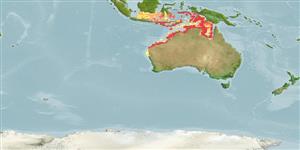Environment: milieu / climate zone / depth range / distribution range
Écologie
marin récifal; profondeur 5 - 50 m (Ref. 90102). Tropical; 3°S - 27°S, 109°E - 141°E (Ref. 3810)
Eastern Indian Ocean: Aru Islands (Indonesia) and northwest Australia. This species closely resembles Pentapodus setosus and Pentapodus paradiseus.
Taille / Poids / Âge
Maturity: Lm ? range ? - ? cm
Max length : 27.0 cm TL mâle / non sexé; (Ref. 9710); common length : 15.0 cm SL mâle / non sexé; (Ref. 3810)
Épines dorsales (Total) : 10; Rayons mous dorsaux (Total) : 9; Épines anales: 3; Rayons mous anaux: 7. Head scales reaching forward to or almost to level of posterior nostrils. Suborbital naked. Lower limb of preopercle naked. Pelvic fins short, not reaching near level of anus. Upper and lower lobes of caudal fin pointed, more or less equal in length. Axillary scale present. Color: Upper body pale brownish, lower whitish. Presence of three bluish stripes across snout, first joining eyes behind nostrils, second in front of nostrils, third from eye to tip of snout. A yellow stripe from behind eye to upper base of pectoral fin and another running from middle of upper lip.
Occurs close to reefs in offshore waters (Ref. 9785). Solitary or small groups (Ref. 90102).
Life cycle and mating behavior
Maturities | Reproduction | Spawnings | Egg(s) | Fecundities | Larves
Russell, B.C., 1990. FAO Species Catalogue. Vol. 12. Nemipterid fishes of the world. (Threadfin breams, whiptail breams, monocle breams, dwarf monocle breams, and coral breams). Family Nemipteridae. An annotated and illustrated catalogue of nemipterid species known to date. FAO Fish. Synop. 125(12):149p. Rome: FAO. (Ref. 3810)
Statut dans la liste rouge de l'IUCN (Ref. 130435)
Menace pour l'homme
Harmless
Utilisations par l'homme
Pêcheries: pêcheries vivrières
Outils
Articles particuliers
Télécharger en XML
Sources Internet
Estimates based on models
Preferred temperature (Ref.
123201): 26.4 - 28.7, mean 27.9 °C (based on 182 cells).
Phylogenetic diversity index (Ref.
82804): PD
50 = 0.5002 [Uniqueness, from 0.5 = low to 2.0 = high].
Bayesian length-weight: a=0.01479 (0.00706 - 0.03101), b=2.97 (2.80 - 3.14), in cm total length, based on LWR estimates for this (Sub)family-body shape (Ref.
93245).
Niveau trophique (Ref.
69278): 3.6 ±0.5 se; based on size and trophs of closest relatives
Résilience (Ref.
120179): Haut, temps minimum de doublement de population inférieur à 15 mois (Preliminary K or Fecundity.).
Fishing Vulnerability (Ref.
59153): Low vulnerability (17 of 100).
Nutrients (Ref.
124155): Calcium = 57.7 [35.1, 116.1] mg/100g; Iron = 0.656 [0.321, 1.603] mg/100g; Protein = 19.1 [17.2, 20.8] %; Omega3 = 0.155 [0.093, 0.259] g/100g; Selenium = 29.7 [17.8, 53.1] μg/100g; VitaminA = 78.1 [22.6, 222.5] μg/100g; Zinc = 1.24 [0.86, 1.78] mg/100g (wet weight);
